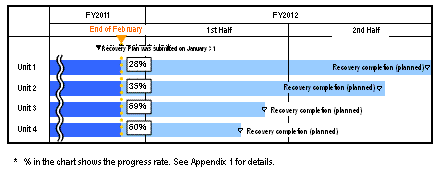Based on the Recovery Plan (submitted and published on January 31, 2012) prepared in accordance with the Nuclear Operator Emergency Action Plan, Fukushima Daini Nuclear Power Station is now proceeding with recovery of facilities for maintaining cold shutdown of the station.
We report the recovery progress status at the end of February 2012 as shown below:
1. Progress status of Recovery Plan
The recovery work of each unit is proceeding steadily, and there is no change in the completion schedule.
 |
2. Major progress statuses based on Recovery Plan (February)
○Unit 4 Seawater Heat Exchanger Building
Recovery of power panel and cables (permanent installation)
On February 24, 2012, followed by the recovery of the power panel (permanent installation), power sources of the residual heat removal equipment cooling system (A), the residual heat removal equipment cooling seawater system (A), and the emergency diesel generator cooling system (A) were switched from the temporary power supply to the power panel (permanent installation). (Reported on February 24 and 25, 2012) [See Appendix 2]
3. Other major progress statuses (February)
○Unit 1 Visual inspection inside the Primary Containment Vessel (PCV) Completed
The inspection inside the Unit 1 PCV was started on December 27, 2011 and the visual inspection was completed on February 28, 2012.
The results confirmed that there was no leakage of reactor coolant, no major deformation or damage was found with each facility, equipment and pipe inside the PCV, and no potential impact on the cold shutdown function was detected. (Reported on February 28, 2012)
○Unit 3 Visual inspection inside the PCV Underway
To check the soundness of the Unit 3 PCV and inside facilities, the visual inspection was started on February 14, 2012. (Reported on February 14, 2012)
In accordance with the four points to consider* specified by the Nuclear Safety Commission when the cancellation of a nuclear emergency situation was declared, TEPCO is committed to continuously pursuing the measures for restoration from nuclear emergency and further reliability improvement.
For the consideration point 4, the facilities subject to the measures are now selected, and the impact assessment will be started after the selection is completed.
End
○Appendixes
・ Appendix 1
Fukushima Daini Nuclear Power Station Progress status based on Recovery Plan (as at the end of February 2012) (PDF 57.6KB)
・ Appendix 2
<PHOTO> Unit 4 Seawater Heat Exchanger Building Recovery of power panel and cables (permanent installation) (PDF 59.6KB)
* Four points to consider specified by Nuclear Safety Commission
On December 26, 2011, the Nuclear Safety Commission submitted a proposal to the Prime Minster that the cancellation of a nuclear emergency situation of the TEPCO Fukushima Daini Nuclear Power Station is allowed to be declared, along with four points to consider for the issuance of the declaration. On January 11, 2012, the Nuclear and Industrial Safety Agency at the Ministry of Economy, Trade and Industry issued instructions to observe the consideration pointes when preparing and implementing the Recovery Plan for Fukushima Daini Nuclear Power Station.
1. Part of the facilities at the Fukushima Daini Nuclear Power Station is temporary installation, to which appropriate maintenance should be provided. The dependence rate of the temporary installation should be reduced according to a plan.
2. The safety facilities for part of the residual heat removal systems have not yet been recovered, to which appropriate management should be provided according to the situation until the recovery of these facilities. In preparing for natural disasters and other incidents, all possible measures should be taken to ensure safety.
3. Thorough safety management including the safety of workers should be implemented.
4. Based on the past pressure and temperature records before cold shutdown that showed abnormal values different from those during a regular period, impacts of these elements on the facilities should be considered